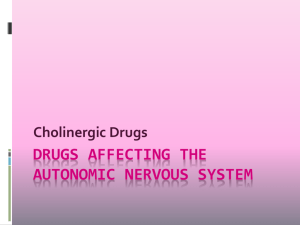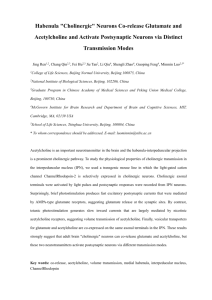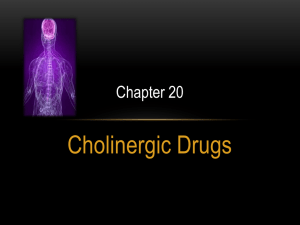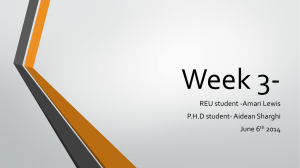CH 4 Practice Questions
advertisement
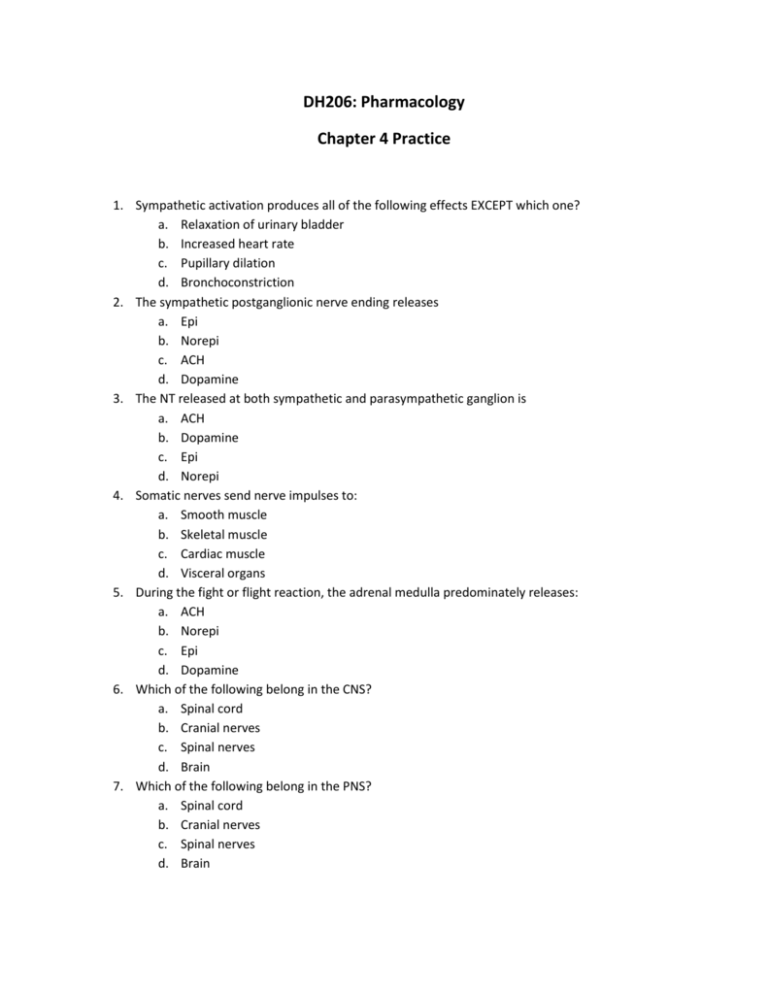
DH206: Pharmacology Chapter 4 Practice 1. Sympathetic activation produces all of the following effects EXCEPT which one? a. Relaxation of urinary bladder b. Increased heart rate c. Pupillary dilation d. Bronchoconstriction 2. The sympathetic postganglionic nerve ending releases a. Epi b. Norepi c. ACH d. Dopamine 3. The NT released at both sympathetic and parasympathetic ganglion is a. ACH b. Dopamine c. Epi d. Norepi 4. Somatic nerves send nerve impulses to: a. Smooth muscle b. Skeletal muscle c. Cardiac muscle d. Visceral organs 5. During the fight or flight reaction, the adrenal medulla predominately releases: a. ACH b. Norepi c. Epi d. Dopamine 6. Which of the following belong in the CNS? a. Spinal cord b. Cranial nerves c. Spinal nerves d. Brain 7. Which of the following belong in the PNS? a. Spinal cord b. Cranial nerves c. Spinal nerves d. Brain 8. Which of the following NT work on the cholinergic nerves? a. Norepi b. Epi c. Catecholamine d. ACH 9. The neurotransmitter released from the post ganglionic ending of a SANS fiber. a. Epinephrine b. Norepinephrine c. ACH 10. What happens when the parasympathetic nervous system is activated? a. All nerves are activated b. Specific nerves are stimulated c. The whole body is stimulated d. No nerves are activated 11. Match the following effects of nervous system activation with the correct division a. Parasympathetic b. Sympathetic 1) Increase GI motility 2) Urinary bladder relaxation 3) Increased heart rate 4) Pupil constriction 5) Urinary sphincter relaxation 6) ACH released 7) Vasoconstriction 8) Increased heart contractility 12. Parasympathetic receptors located on the membranes of the internal organs are classified as: a. Alpha-1 b. Nicotinic-neural c. Nicotinic-muscle d. Muscarinic 13. Select the pharmacologic effect produced by cholinergic drugs. a. Increased heart rate b. Increased GI motility c. Decreased urination d. Pupillary dilation 14. Pilocarpine is classified as a(an): a. Direct-acting cholinergic drug b. Reversible anticholinesterase inhibitor c. Irreversible anticholinesterase inhibitor d. Anticholinergic drug 15. Physostigmine (Eserine) is classified as a(an): a. Direct-acting cholinergic drug b. Reversible anticholinesterase inhibitor c. Irreversible anticholinesterase inhibitor d. Anticholinergic drug 16. Symptoms of cholinergic drug over-dosage include a. Slow pulse rate b. Increased urination c. Diarrhea d. All of the following 17. Treatment of cholinergic drug over-dosage is accomplished with a. Atropine b. Pilocarpine c. Physostigimine d. Bethanechol 18. Anticholinergic actions include all of the following EXCEPT a. Bronchodilation b. Increased heart rate c. Increased GI activity d. Decreased respiratory secretions 19. The antidote for atropine poisoning is a. Scopolamine b. Bethanechol c. Neostigmine d. Physostigmine 20. Tolterodine (Detrol) is indicated for treatment of a. Motion sickness b. Relief of urinary incontinence c. Ophthalmic exams d. Glaucoma 21. Which of the following are used for the treatment of myasthenia gravis? a. Tensilon b. Mytelase c. Prostigmin d. Mestinon 22. Select the conditions produced by anticholinergic drugs. SELECT ALL THAT APPLY. a. Mydriasis b. Relax smooth muscle KNOW THIS! c. Decrease salivation d. Sedation 23. Which of the following are NOT cholinergic receptors? a. Muscarinic b. Nicotinic-neural c. Nicotinic-muscle d. Sympathomimetic 24. Pick the correct pharmacological effects of direct-acting cholinergic drugs. a. Respiratory paralysis b. Urinary retention c. Increased heart rate d. Bronchodilation 25. Which of the following would be a preferred treatment for overactive bladder? a. Cognex b. Detrol c. Pilocar d. Bentyl 26. The main pharmacologic effect of norepi on alpha-1 receptors is: a. Increase heart rate b. Bronchodilation KNOW THIS! c. Vasoconstriction d. Contraction of urinary bladder 27. Epi stimulates a. Alpha receptors b. Beta-1 receptors KNOW THIS! c. Beta-2 receptors d. All of the above 28. At therapeutic doses, albuterol stimulates a. Alpha receptors b. Beta-1 receptors c. Beta-2 receptors d. All of the above 29. Which of the following agents is used in the treatment of glaucoma? SELECT ALL THAT APPLY. a. Cholinergic b. Anticholinergic KNOW THIS! c. Sympathomimetic d. Sympatholytic 30. Propranolol is classified as a(an) a. Alpha blocker KNOW THIS! b. Nonselective beta-blocker c. Selective beta-1 blocker d. Adrenergic neuronal blocker 31. The drug of choice to treat acute allergic reactions is a. Norepi b. Phenylephrine c. Pseudoepherdrine d. Epi 32. Select all the processes that occur with stimulation of a beta receptor a. Decreases artery constriction b. Increases heart rate KNOW THIS! c. Relaxes smooth muscle d. Dilation of pupils 33. Which receptor is responsible for vasodilation & constriction? a. Alpha-1 b. Alpha-2 KNOW THIS! c. Beta-1 d. Beta-2 34. Which of the following are actions of beta-adrenergic blocking drugs? a. Decreasing heart activity b. Preventing NE from working c. Interfere with lipid metabolism d. Lowering blood pressure e. Vasodilation 35. Select the effects of epi on the body a. Bronchodilation b. Vasoconstriction c. Relaxation of uterus d. Increased heart conduction Match the definitions or descriptions in the left column with the appropriate terms in the right column 36. Drug that blocks or decreases sympathetic nervous system activity 37. Drug that acts at the neuronal endings to reduce the formation or release of NE 38. Receptor that mediates smooth muscle contraction 39. Adrenergic receptor located on either the heart or smooth muscle 40. Drug that blocks both beta-1 and beta-2 effects of epi 41. Drug that blocks alpha effects of Norepi and epi 42. Chemical classification of norepi and epi 43. Adrenergic drug or effect that increases sympathetic nervous system activity 44. Hormone released from the adrenal medulla that stimulates the sympathetic nervous system a. Adrenergic neuronal blocker b. Alpha-blocker c. Alpha-receptor d. Beta receptor e. Catecholamine f. Epi g. Nonselective beta blocker h. Sympatholytic i. Sympathomimetic 45. In the ANS, the target organ is innervated by the __________ neuron. a. Preganglionic afferent b. Preganglionic efferent KNOW THIS! c. Postganglionic afferent d. Postganglionic efferent 46. The neurotransmitter released from a preganglionic neuron in the sympathetic division of the ANS is: a. Epinephrine b. Norepinephrine c. Dopamine d. Acetylcholine 47. Which of the following substances will block the action of acetylcholine at the postganglionic endings in the PANS? a. Atropine b. Pilocarpine c. Hexamethonium d. Acetic acid 48. Which of the following statements is true concerning direct- and indirect-acting cholinergic agents? a. A direct agent causes release of neurotransmitter and an indirect agent acts on the receptor. b. The indirect-acting agents include the choline derivatives and pilocarpine. c. The indirect-acting cholinesterase inhibitors act by stimulating release of acetylcholine. d. Inhibiting the enzyme that normally destroys acetylcholine results in stimulation of the PANS. 49. The direct effect of acetylcholine on the heart is: a. Negative chronotropic and negative inotropic b. Positive chronotropic and positive inotropic c. Negative chronotropic and positive inotropic d. Positive chronotropic and negative inotropic e. None of the above 50. Which of the following choices is true concerning the pharmacologic effects associated with cholinergic agents? a. Decrease urinary incontinence b. Stasis of intestinal motility c. Miosis d. An increase in intraocular pressure 51. The acronym SLUD denotes adverse reactions associated with administration of __________ agents. a. Cholinergic KNOW THIS! b. Anticholinergic c. Adrenergic d. Antiadrenergic 52. Which of the following conditions is not a relative contraindication or caution with the use of cholinergic agents? a. Bronchial asthma b. Hypothyroidism c. Myasthenia gravis treated with neostigmine d. Peptic ulcer 53. Muscarinic receptors are associated with: a. PANS KNOW THIS! b. SANS 54. Anticholinergics: a. Accelerate gastric emptying b. Decrease gastric motility c. Cause miosis d. Do not have an effect on heart rate 55. Which of the following categories of ANS agents can cause an acute rise in intraocular pressure in patient with narrow-angle glaucoma? a. Cholinergic b. Anticholinergic 56. Stimulation of β2-receptors results in: a. Vasoconstriction of skin and skeletal muscle KNOW THIS! b. Increase in heart rate and force of contraction c. Smooth-muscle relaxation d. Bronchoconstriction 57. Sympathomimetic agents will stimulate salivary flow from which of the following salivary glands? (1) parotid, (2) submandibular, (3) sublingual a. 1, 2, 3 b. 1, 2 c. 1, 3 d. 2, 3 58. Sympathomimetic agents should be used with caution in patients with (1) angina, (2) hypertension, (3) hypothyroidism. a. 1, 2, 3 b. 1, 2 c. 1, 3 d. 2, 3 59. Patients pretreated with __________ are prone to epinephrine reversal. a. Cholinergic agents b. Anticholinergic agents c. α-Adrenergic agents d. α-Adrenergic blocking agents 60. All of the ANS drug classes can be used safely in patients with glaucoma EXCEPT which one? a. Cholinergic agents b. Anticholinergic agents c. Sympatholytic d. Sympathomimetic 61. Which agent would you use for nasal congestion? a. Cholinergic agents b. Anticholinergic agents c. Sympatholytic d. Sympathomimetic 62. Which of the following classes of drug has no clinical use? a. Alpha-1 blocker b. Alpha-2 blocker c. Beta-1 blocker d. Beta-2 blocker 63. Which of the following drug classes can be used in the treatment of Raynaud’s? a. Cholinergic agents b. Anticholinergic agents c. Sympatholytic d. Sympathomimetic 64. The stimulation of which receptor can result in vasodilation. a. Alpha-1 b. Alpha-2 c. Beta-1 d. Beta-2 65. The stimulation of which receptor can result in vasoconstriction. a. Alpha-1 b. Alpha-2 c. Beta-1 d. Beta-2 66. Which of the following drug classes can cause vasodilation? SELECT ALL THAT APPLY. a. Sympathomimetic alpha-1 b. Sympathomimetic alpha-2 c. Sympathomimetic beta-1 d. Sympathomimetic beta-2 e. Sympatholytic alpha-1 f. Sympatholytic alpha-2 g. Sympatholytic beta-1 h. Sympatholytic beta-2 67. If a patient was in heart failure, they could be taking a sympathomimetic beta-1 selective drug. However, if the patient had hypertension, they could be taking a sympatholytic beta-1 or sympathomimetic alpha-2 drug. a. Both statements are true b. Both statements are false c. The first statement is true, the second is false d. The first statement is false, the second is true 68. List all the conditions a patient could be taking a nonselective beta-blocker for. ANSWERS 1.D 2.B 3.A 4.B 5.C 6.A,D 7.B,C 8.D 9.B 10.B 11. A,B,B,A,A,A,B,B 12. D 13. B 14. A 15. B 16. D 17.A 18. C 19. D 20.B 21. C,D 22. A,B,C,D 23. D 24. B 25. B 26. C 27. D 28. C 29. A,D 30. B 39. D 40. G 41.B 42.E 43.I 44.F 45.D 46.D 47.A 48.D 49.A 31.D 32.B,C 33.A 34.A,B,C,D 35.A,B,D 36.H 37.A 38.C 50.C 51.A 52.B 53.A 54.B 55.B 56.C 57.D 58.B 59.D 60. B 61. D 62. D 63. C 64. D 65. A 66. D,E 67. A

